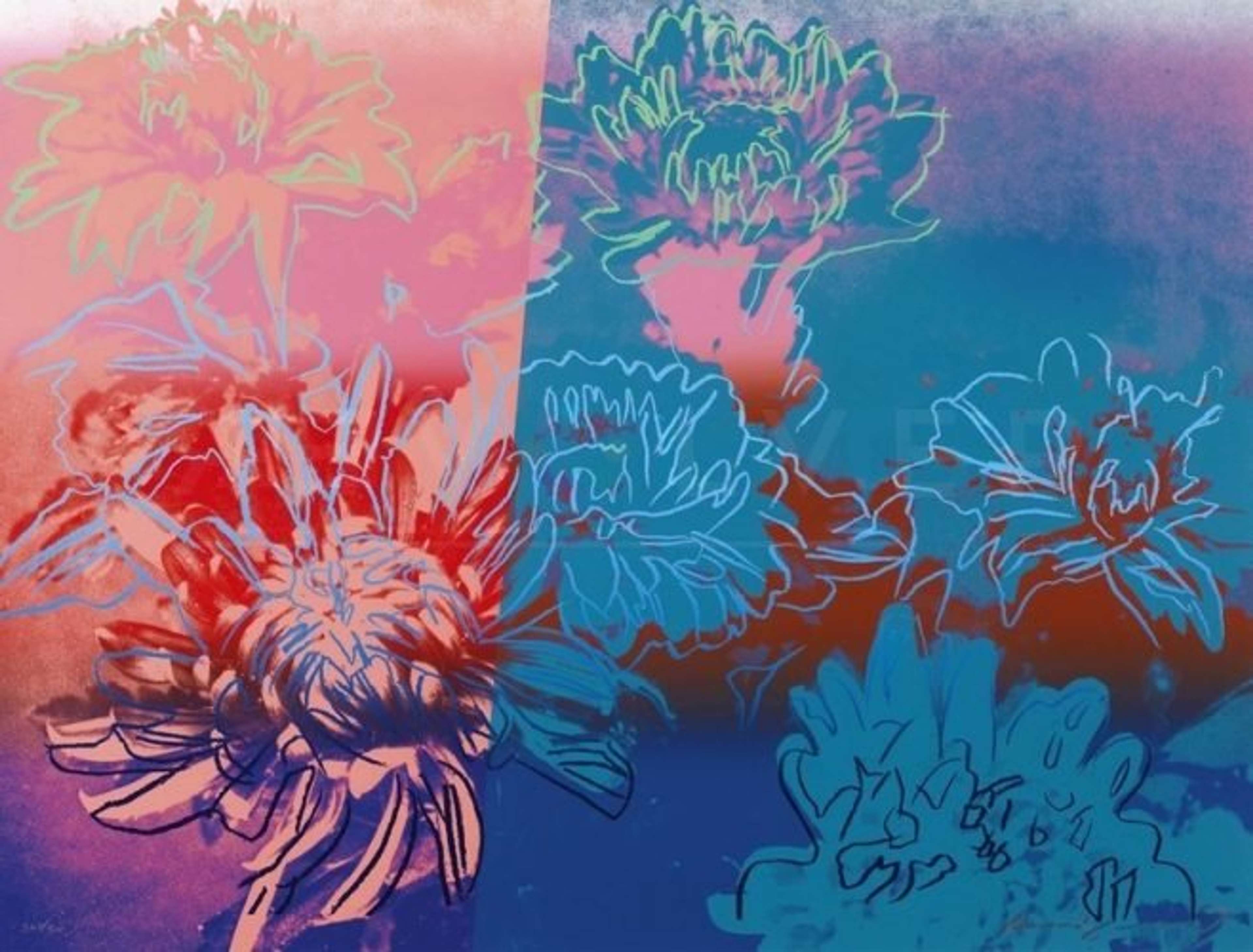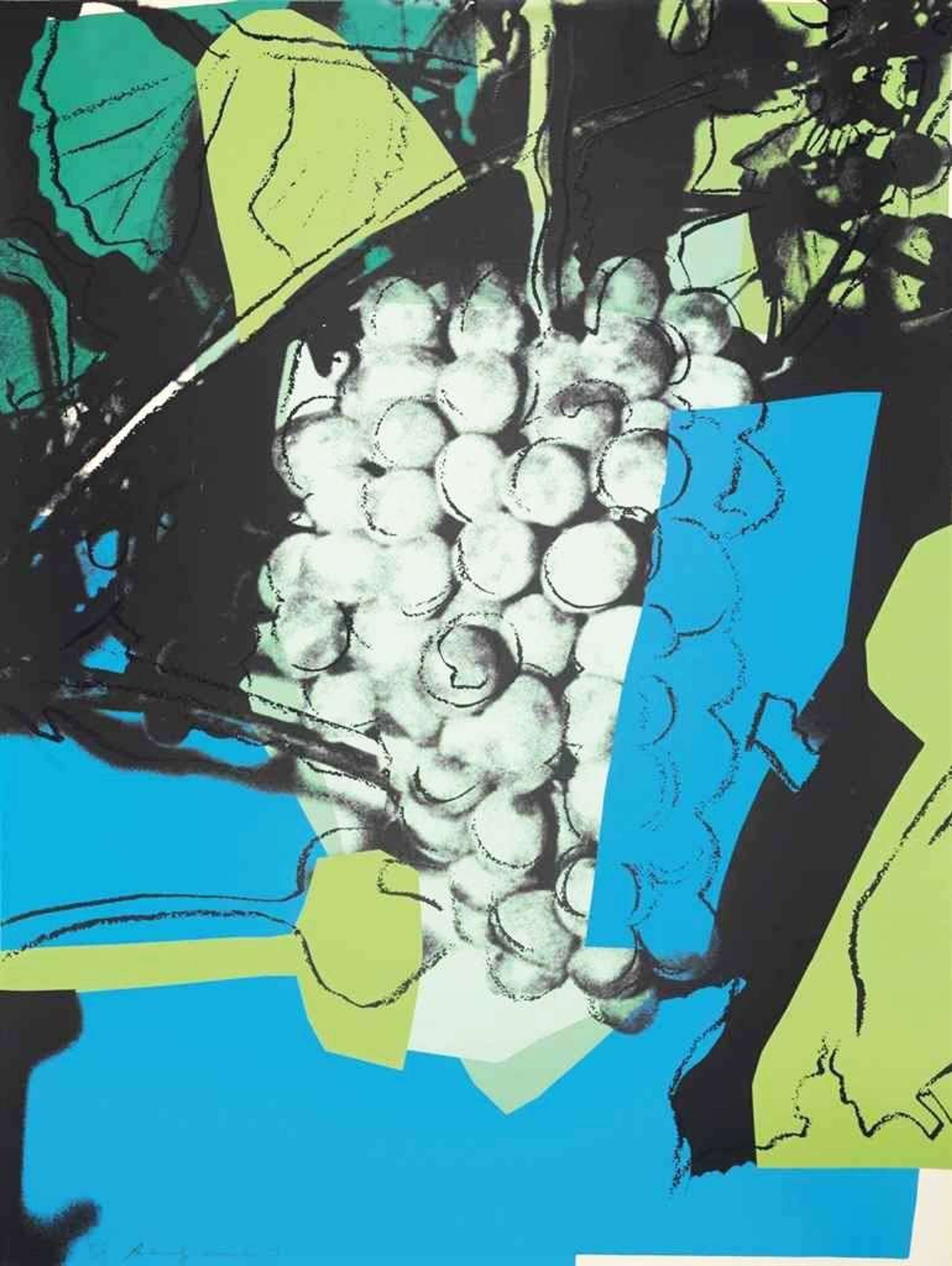 Kiku (complete set) © Andy Warhol 1983
Kiku (complete set) © Andy Warhol 1983
Interested in buying or selling
Andy Warhol?

Andy Warhol
487 works
Commissioned by Fujio Watanuki in 1982, Andy Warhol's Kiku series depicts the chrysanthemum flower on a uniquely small scale. Executed in Warhol’s distinctive Pop style of the 1980s, the series is an homage to Japanese culture and print making tradition.
The series depicts the Chrysanthemum flower.
 Kiku (F. & S. II.307) © Andy Warhol 1983
Kiku (F. & S. II.307) © Andy Warhol 1983In this unconventionally small print portfolio, Warhol depicted the blossoming chrysanthemum flower across three screen prints. In his archetypal style, Warhol transformed the natural colouring of these blossoms, making them appear artificial and graphic. Particularly in Kiku (F. & S. II.307), the gradient background foregrounds Warhol’s considered outlining of the flower’s petals. Despite their small scale, the Kiku prints are dynamic and compelling.
Warhol regularly depicted flowers since 1964.
 Flowers (F. & S. II.6) © Andy Warhol 1964
Flowers (F. & S. II.6) © Andy Warhol 1964Since the early days of his artistic career, Warhol depicted a wide variety of flowers. From his extensive Flowers series in the 1960s, to depictions of singular flowers in the 1980s, flowers are one of Warhol's most frequently revisited subjects. With his signature Pop palette, Warhol transforms the delicate flower into a bold two-dimensional presence in his prints.
The series was commissioned by Fujio Watanuki.
 Kiku (F. & S. II.309) © Andy Warhol 1983
Kiku (F. & S. II.309) © Andy Warhol 1983This 1983 screen print series was commissioned by Fujio Watanuki, a proponent of the Japanese avant-garde and founder of the Gendai Hanga Center in Tokyo. Watanuki invited Warhol to create the Kiku series, signifying both Warhol’s global appeal and the artist’s interest in Japanese iconography in his own printing process.
The style of the series is in keeping with Warhol's style in the 1980s.
 Gems (F. & S. II.88) © Andy Warhol 1978
Gems (F. & S. II.88) © Andy Warhol 1978As Warhol's style matured in the 1980s, he opted for more expressive mark making on the surface of his prints, using a black pen after overlaying blocks of printed colour. Much like his Gems and Love series, Kiku is characterised by colourful and deliberate line work, and a more limited palette than his earlier works.
The prints in this series are uniquely small in scale.
 Kiku (complete set) © Andy Warhol 1983
Kiku (complete set) © Andy Warhol 1983Measuring just 19 3/4 × 26 in, the Kiku prints are unusually small for Warhol. In their smaller scale, these works are more akin to traditional still life works than his typical output. Also, the smaller size of these works gives the impression of a greater attention to detail.
The series unites the genres of still life and abstraction.
 Grapes (F. & S. II.193) © Andy Warhol 1979
Grapes (F. & S. II.193) © Andy Warhol 1979Much like his Grapes series, created just two years before Kiku, this screen print series straddles the genre of still life and abstraction. Though Warhol clearly delineated each petal of the chrysanthemum flower with intricate detail, the artificial colour palette and collage effect - as we see in Kiku (F. & S. II.308) - challenges the norms of representation.
The chrysanthemum is the traditional symbol of the Japanese Emperor.
 Kiku (F. & S. II.308) © Andy Warhol 1983
Kiku (F. & S. II.308) © Andy Warhol 1983The chrysanthemum flower - named ”kiku” in Japanese - is the traditional symbol of the Japanese Emperor. This is an enduring and ubiquitous image in Japanese culture, appearing on the Japanese passport and acting as the seal for the imperial family. By rendering the kiku in his distinctive Pop style, Warhol paid his own tribute to Japanese tradition and culture.
The series was produced with Japanese living spaces in mind.
 Sunset © Andy Warhol 1972
Sunset © Andy Warhol 1972Executed on a small scale, the Kiku prints were designed with compact Japanese living spaces in mind. Even with a frame, these prints are much smaller than the majority of Warhol’s prints, making them more accessible for collectors past and present.
Warhol was fascinated with flowers.
 Flowers (F. & S. II.114) © Andy Warhol 1974
Flowers (F. & S. II.114) © Andy Warhol 1974Flowers were a career-spanning fascination for Warhol, and the plethora of prints dedicated to flora are a true testament to that. Warhol himself once remarked, ”I always notice flowers”, and so it is no surprise that his preoccupation should translate into his art.
The series is a testament to the global influence of Warhol's art.
 The Shadow (unique) © Andy Warhol 1981
The Shadow (unique) © Andy Warhol 1981As a commission for Watanuki, the Kiku series proves the global influence and popularity of Warhol’s Pop Art. Indeed, by the 1980s Warhol had achieved celebrity status - reaching the same level of stardom as some of his star-studded muses. Until his death in 1987, Warhol was to remain popular with his prints becoming increasingly covetable for patrons - if they could afford the King of Pop’s excessive rates.
